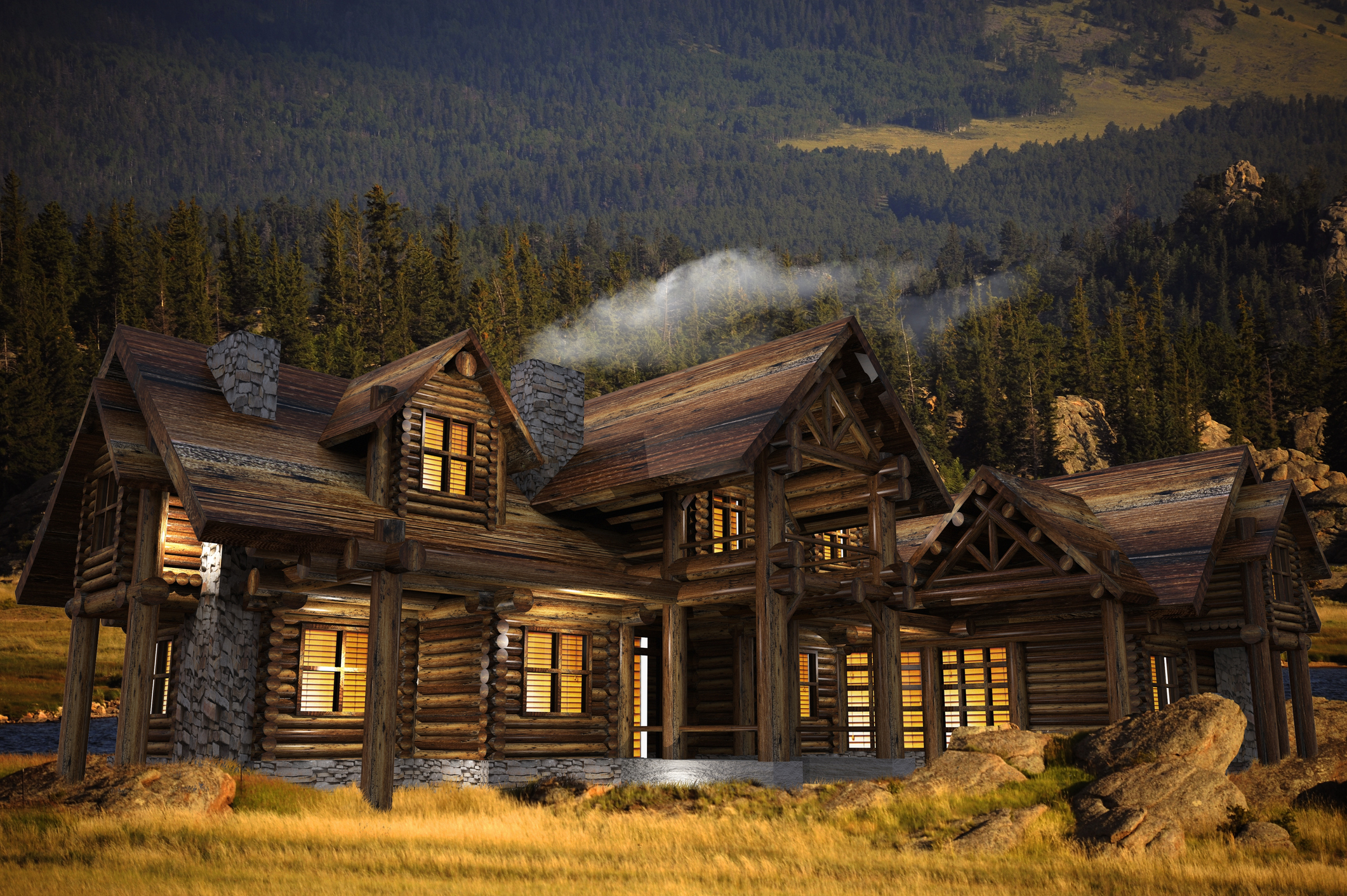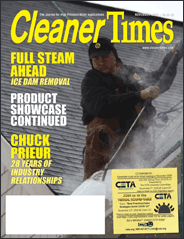
Cleaning Log Homes
by Diane M. Calabrese | Published June 2025

Is the past prologue? William Shakespeare’s line from “The Tempest” is a favorite among those who suggest we have a solid idea where things are heading if we look at what’s already happened.
Seems reasonable. AI has not been around long, but we already know two things about it: It’s fast moving and unstoppable – and voracious.
Devouring numerical data and text alike, AI can collect, consolidate and convey instantaneously. Take log homes. We looked for data on their number in the United States and Gemini, the “experimental” AI tool from Google, returned in outline form information about popularity, types, companies that do construction and factors would-be owners should weigh.
Every expert who goes on record with information should expect to become fodder for the hungry AI beast. (And we use “beast” in a neutral sense.)
For now, there is something unique about the voices of people who have who have done and are doing things in the real world. Let’s take advantage of it.
Russell Cissell, founder of Extreme Solutions, Inc. (Woodrich Brand) in Portage des Sioux, MO gets us started with some of the basics. First, yes, there is a role for pressure washers when cleaning log homes.
“Keeping it dialed back to a safe psi” is the key to safe use of a pressure washer on a log home, says Cissell. That, and maintaining a safe distance from the wood.
“There are certainly special considerations when using a power washer on a log home,” says Cissell. They include “being sure the seals are good — chinking is intact and there’s no water infiltration being most important.”
Cissell cautions that a contractor engaged in cleaning log homes must know the exact nature of the substrate. “There’s a difference between restoring log-shaped siding and taking on a true log home restoration,” he explains.
Yet there are similarities with more routine projects. “I would say like any exterior surface, the best recommendation is going to be clean early and clean often,” says Cissell
“The more frequently you clean, the more gently you can clean effectively,” explains Cissell. “Specifically for log cabins, you want to clean any time there are significant signs of pollen outside.”
Pollen is a crucial indicator of potential trouble. “If you see pollen on your car, your outdoor furniture or your barbecue grill, there’s a real good chance there’s going to be pollen on your logs, and that pollen over time will become a source for mold and mildew,” explains Cissell.
In fact, temporizing measures can be important between cleanings. “It’s best to just rinse the surface off anytime you see pollen outside,” says Cissell.
“Fundamentally, all exterior wood restoration and preservation projects are the same regardless of whether it’s a deck, fence, wood siding or a log cabin,” explains Cissell. “Log cabins require the most expertise and the most care just due to the potential for water infiltration and concerns around chinking and making sure you have a good seal.
“But otherwise, the methods that you use, the chemicals involved, the types of sealers that you could use on log cabins can be very similar to what you use on wood siding,” continues Cissell. And the similarity brings us to an important consideration for contractors.
The consideration is volume. Some contractors try adding log home cleaning but then find that the service does not offer enough return on investment. A big reason is there are too few homes in a region and still, the necessary chemicals must be on hand to complete the jobs.
The idyll of a home in a remote setting built from logs that have not been debarked exists. But that’s the exception.
So, too, is the exception that log home builders have a poetic idea about natural destruction and decay – i.e. they want their structures to disintegrate. True, a few owners do hold tight to the concept of gradual reclamation by nature. But they will not be the individuals seeking cleaning services.
Variation
“Log homes are not universal per se in their construction and that is because many are built by contractors that have only ever built one,” says Rod Rodriguez, president of See Dirt Run! Inc. in Germantown, MD. That means a contractor must know coatings that have been applied and the manufacturer’s instructions for maintenance.
Has the wood weathered, and the coating failed? Then cleaning “is pretty straightforward,” says Rodriguez.
Straightforward, if other factors are in place, explains Rodriguez. Caulking between logs must be in good condition. And an interior inspection must be done to detect any leakage. In addition, window trim and applied trim facings should have been sealed. Caulking also must be in place under eaves/soffits with tongue and groove.
Then, there are doors. “Wood doors of any type installed on the home should be avoided unless one is including them in the quote,” says Rodriguez. If quoting to clean doors, remember they must be removed and allowed to dry thoroughly (to avoid swelling and misalignment when rehung), he adds.
The focus of the contractor must be to clean without introducing water damage. It’s a balancing project.
So, what about the utility of pressure washers? “A pressure washer can be used in the process, but the tool should not be the only source of cleaning,” says Rodriguez.
Moving ahead without assessment leads to trouble. “[The] pressure washer can blast the wood to create culling and a profile in the wood easiest identified as a ‘corduroy’ texture,” explains Rodriguez. As a result, buffing (sanding) might be required to restore the surface to its original look.
“Many logs are milled to have a smooth finish and anything else is unacceptable to the homeowner,” says Rodriguez. He adds that professional contractors take exacting care to ensure the result is the one the homeowner expects.
Candor is a must when establishing parameters. “Many log homes have reached a condition of disrepair and neglect and need more than just the wash and recoat,” says Rodriguez. And given the opportunity, a contractor should emphasize the long-term savings achieved with regular maintenance.
Planning to offer home cleaning as a service? “Learn about the construction,” says Rodriguez. “A log home/cabin is not just a vertical deck.”
Begin with learning about how the logs are joined. Construction methods are focused on “joining of each course of logs with mortice and tenon joints, cove setting and splines to help bridge one log with the next,” explains Rodriguez.
“Most [log homes] have a membrane or sticky contact applied between the logs but over time, the pressure of the logs on top cause a lot of heat which destroys the flexibility and sticking capabilities resulting in water penetration between the courses into the interior and worse, electrical installed in the logs themselves,” says Rodriguez. And water penetration can cause serious trouble.
Log homes subject to flooding, for instance, may become a fire hazard. If building and electrical codes were not adhered to during construction, there could be substandard connections” with the potential for danger, explains Rodriguez.
“We have had some [log homes] where the outlet filled behind with water — failed weather seal around the box, and caused the connection inside to begin sparking,” says Rodriguez. “There was not GFCI, ground-fault circuit interrupter, installed and the breaker box was not responding by shutting off the circuit. It had to be done manually.”
Never forget that the rustic-looking log home is much more than a pile of logs. “It is a construction that contains electrical wiring, fasteners and tie rods — for helping control contraction of the logs, elements for helping to seal out the weather, insects,” says Rodriguez.
A contractor who fails to imbibe the intricacies of log home structure could be open to liability by causing damage. No, the contractor is not liable for the construction. The builder is.
But the cleaning contractor must identify potential risks and determine not to encounter them. For instance, cleaning with water may not be an option. “There are dry methods that should be employed instead if the conditions are too great a risk for damage,” says Rodriguez.
Dry methods may apply in many situations. They “are also considered if the log home has considerable rot issues or is susceptible due to construction and shrinking
causing gaps in the chinking or caulk that would allow the water to get in between and exacerbate the issue,” explains Rodriguez.
Commonalities?
A contractor has been cleaning cedar siding for a long time. Is a crossover to log homes simple?
“A pressure washer being used is the only commonality that comes to mind,” says Rodriguez. “Cedar siding has the issue of being lifted during the wash process and needs to be addressed with the potential of it happening.
“Cedar siding whether it be lap or shingles can have attrition due to fasteners failing, missing or the substructure becoming unsound due to damage from moisture retention or exposure from landscape element and installed fixtures – AC units, pop-up sheds etcetera,” continues Rodriguez.
In contrast, explains Rodriguez, “logs have the water intrusion through the many joints, corners, windows, doors and log course.” Proactive abatement requires investment of time and team members to install plastic draping, for example.
When builders have been scrupulous in attention to details for mitigating or eliminating water penetration, both cedar and log homes offer fewer challenges to cleaning contractors. Thus, assess the structure carefully before giving an estimate or setting expectations with the owner.
Cleaning log homes encompasses more activities than cleaning vinyl or siding. “Caulking and other insulative measures come into play much more frequently and need to be addressed either by repair or complete replacement,” says Rodriguez.
Log home cleaning takes a contractor deeply into the territory of home restoration specialist. “Which skills are required to work on cleaning log homes?” is the first question a contractor should ask before venturing into the service offering, says Rodriguez. “There are many including carpentry, construction, roofing, electrical and believe it or not painting.” Gutter troughs and window frames may need to be painted after exposure to chemicals/cleaning.
The cleaning involves much more than eliminating soiling, explains Rodriguez Previous coatings may have to be removed. Often new ones must be found because formulations change and products are discontinued due to things like regulatory compliance (see, for example, volatile organic compounds, VOCs).
Also, expect to encounter bad results from good intentions: Some homeowners were persuaded to paint log homes to “get longer durability and easier maintenance,” says Rodriguez. “Problem is many [paints] that have been applied are not permeable and hold water behind the coating leading to massive rot issues and costly remedy.”
The paint can be removed with blasting media, explains Rodriguez. Then, a suitable coating – oil or acrylic – can be applied. “Solid colors are never suggested because they hide the condition of the wood which needs to be monitored for changes and signs of possible issues.”
Uniqueness
Cleaning log homes means also taking on restoration work – a small amount at least and perhaps a lot. Take to heart what experts (with human voices) tell us.
“The niche trade of log home restoration is a class unto itself in the scope of other specialization that needs to be gained in order to provide the best service and develop a relationship of confidence with the owners of these log structures that enjoy the look and function they provide,” says Rodriguez. “[The homes] are cozy and relaxing to be in which is the draw of their desire to have one.”
A comfortable retreat may be just the counterbalance for a time (ours) when we remain unsure whether the past is prologue, after all. Not the basic sort of cabin where our sixteenth president read by candlelight, but reminiscent enough of Abraham Lincoln’s environs to ease concerns.
There’s no doubt at all that ravenous AI will continue to ingest all that it can, as it aggregates and disseminates information.
So just how many log homes are there in the United States? Approximately 550,000, according to Gemini and the U.S. Census Bureau.





